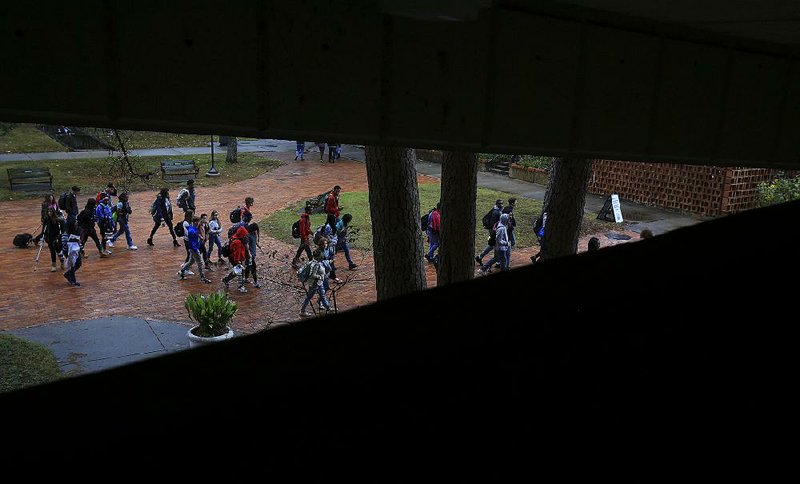The University of Arkansas at Little Rock's enrollment isn't as bad as anticipated, which will translate into $3.5 million to $4 million more than budgeted for, Chancellor Christina Drale told the university's faculty senate on Friday.
The revelation was the opposite of the news that arrived around this time last year, when former Chancellor Andrew Rogerson resigned and Vice Chancellor for Finance and Administration Steve McClellan told the faculty senate the university would fall $5 million short of its anticipated revenue because its enrollment projections had been far too rosy.
But it wasn't all good news Friday. The university's enrollment of new students -- particularly first-time freshman and transfer students -- was down about an eighth of where it was last year. That was in spite of increased scholarship opportunities for those students and hundreds more applications and admissions to the university.
"We were enormously disappointed in that," Drale said. "We really just didn't believe there was any way we wouldn't end up positive there."
UALR's enrollment slide, down to 8,063 students this fall, has been ongoing for the past decade, coinciding with a handful of years, nonconsecutive, of at least a $1 million deficit.
"In the past, I don't think we planned for the enrollment declines effectively, and so it did catch us by surprise," faculty senate President Amanda Nolen said in an interview after Friday's meeting.
Under Drale's one year as chancellor, the university has made several permanent and temporary cuts to its budget, including a layoff of several faculty members, the elimination of several academic programs and the reduction of administration through consolidation of the university's five academic colleges into three.
Drale also moved Friday to make another initiative, begun by her predecessor, a permanent part of the university's operations.
Drale proposed making permanent the Institutional Effectiveness Committee, which evaluated budgeted administrative and academic departments according to their efficiency, value to the university's mission, and effectiveness at carrying out their missions. Drale's proposal would enshrine the committee in the university's constitution.
The faculty senate approved the proposal, which will be voted on by the University Assembly on Oct. 2. It must be approved at two consecutive meetings. The second meeting this academic year is scheduled for April 2.
A member of the committee, John Hendon, told the senate he believed the committee was necessary in the long run. The university needs a continuing review of its units to ensure the university is properly maintained.
"We have units that 30 years ago had a powerful purpose that today I'm not sure what those purposes are, and we don't have units that probably should exist," said Hendon, an advanced instructor of management. "The IEC was the committee that really dug into that when we got into a bind financially. And I think financially we are going to continue to struggle until we find the things that need to be funded at lower levels than they currently are."
Andrew Wright, associate professor of systems engineering, lamented the changing environment that surrounded the committee since its inception two years ago. It was used differently by each chancellor. Putting it into the university constitution would give it "formal structure."
Faced with the challenges of the novel coronavirus pandemic, coinciding with the university's efforts to turn around its enrollment decline and financial disarray, UALR budgeted for a 10.8% enrollment drop this fall.
Instead, the university counted a 5.5% reduction in students and a 3.9% reduction in credit hours enrolled in. That's in large part because of increased retention of existing students, although numbers weren't available Friday on how much retention increased.
"Retention is what saved us," Drale told faculty.
The student affairs office will conduct a "post-mortem" on the enrollment numbers, Drale said, including an examination of why the number of new students decreased. She said many prospective new students have deferred their enrollment until at least January. How many students deferred is unclear.
Drale was frustrated by the enrollment numbers, despite being less harmful than expected for the university for the time being.
University leadership had projected lower enrollment this year, even before the pandemic, and had anticipated enrollment ultimately leveling out and increasing in just a couple of years. Leaders based those expectations on new initiatives and larger incoming classes.
So the drop in new students changes the university's longer-term projections, Drale said.
Nolen is still a believer in the university's plan to reverse its course. It's only been one year, and enrollment was negatively impacted by the pandemic, she said.
"We have strategic enrollment plan, and it's well thought out, and it's grounded in best practices, and I really believe in it," Nolen said. If the university continues with it, she said, enrollment will level out, if not go back up.

